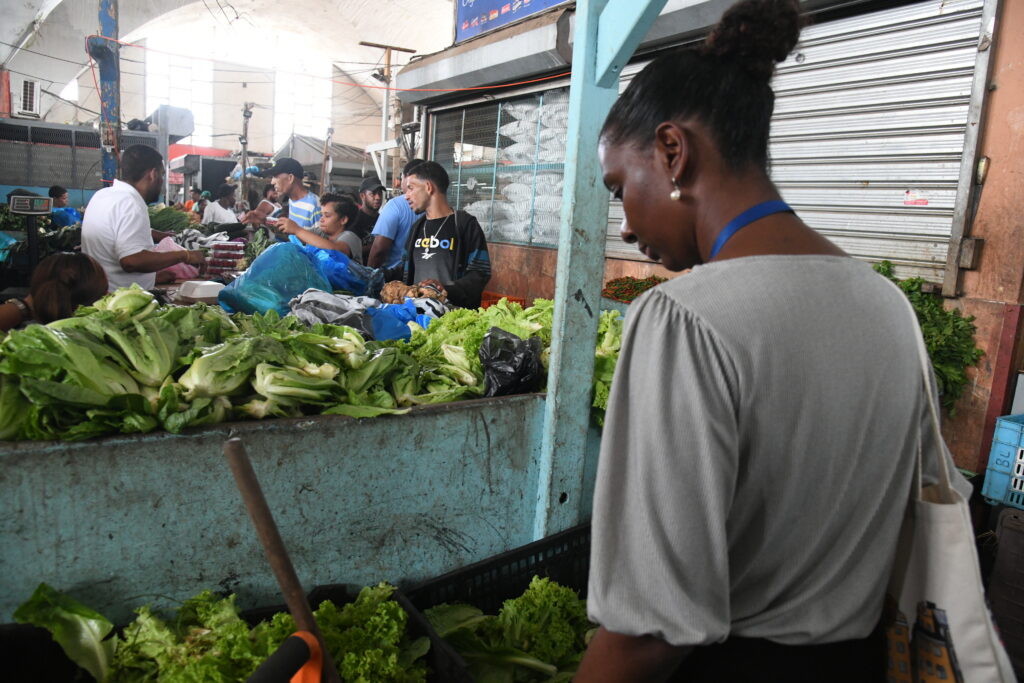Summer had barely started, and temperatures were already forecast to reach up to 35 degrees Celsius. Just as people are encouraged to stay hydrated and wear light clothing during hot weather, it’s important to consider how high temperatures can also impact foods like fruits and vegetables that are often exposed to the sun.
In the Duarte Market in the capital and its surroundings, there are notable characteristics: the large heaps of garbage or makeshift mini-dumps where waste is discarded; the stench of garbage and rotten food; and the large number of vendors selling fruits and vegetables harvested or planted in Dominican soil. Often, these are left under the scorching sun without any cover, causing them to spoil faster and impacting the vendors’ income.
Ramón María Jiménez has been selling bananas outside the Duarte market for fifteen years. Every day, he buys dozens of boxes that come directly from the province of Valverde, Mao, in the northwest of the Dominican Republic. He starts his business at 3:00 a.m., but despite this, the intense heat ends up ruining them. When they are in better condition, he sells them for five pesos each, but the next day, they would already be priced at about three pesos each. Every week, he faces losses in both fruit and money. By the end of June, he had to discard 60 boxes containing approximately 12,000 to 13,200 bananas because they had been damaged by the heat. He lost about 30,000 Dominican pesos in the process. In his case, he covers some boxes containing the fruit with a piece of cardboard, but usually, he stores them in a garage, which is also very hot.

Siliana Castillo faces the same situation. She opens her stand outside the market from 4:00 a.m. to 4:00 p.m., selling only peppers and tomatoes. Her buyers have decreased because it is common for these to spoil quickly due to the heat. Unlike Ramón, Siliana leaves them exposed to the sun without any cover. She explained that sometimes these vegetables come damaged from the field, and that makes the heat spoil them even faster. She sells these vegetables at a minimum price of 30 Dominican pesos (less than a US dollar).
Halen Cedeño has been working in the Duarte market for 27 years. It was his father’s business, and he has been helping since he was a teenager. Cedeño assured that now the heat is worse than ever, and although he is in a covered area of the market, the high temperatures still affect the products he sells. These include lettuce, parsley, cauliflower, and strawberries, the latter being one of the most affected because they are initially exposed to the cold of the mountains in Constanza, La Vega, and then move to the heat of the capital.
Regarding lettuce, he has to buy a thousand pounds daily because it spoils in the intense heat. Nelson Ortega, a mango vendor at the market, is another one affected. Every day, he buys between 15 and 20 boxes of this fruit. He said they spoil faster because of the current heat, so he opts to place them under a tarp to keep them fresh longer.
On the other hand, Rafael Polanco, another vendor, does not recommend storing these products in a cold room or on ice because once they are taken out, they spoil even faster.
How Can It Affect Health?
According to nutritionist María Matos Terrero, high temperatures can accelerate the ripening process of fruits and vegetables, which can reduce their shelf life by causing water evaporation from these foods, leading to dehydration and loss of freshness and texture. Therefore, prolonged exposure to the sun can cause the loss of certain nutrients, such as vitamins C and A, which are sensitive to high temperatures. This can lead to the growth of bacteria and fungi, resulting in product loss and altering the taste and texture of fruits and vegetables, making them less attractive for consumption.

To minimise these effects, it is important to store fruits and vegetables in cool places and refrigerate them appropriately when necessary.
Jorge Tallaj, academic coordinator of the School of Natural and Exact Sciences at the Pontifical Catholic University Madre y Maestra (PUCMM), added that each vegetable or fruit will be affected differently. Extreme heat accelerates the respiration of tissues and other metabolic processes, such as ripening, which can result in a shorter shelf life for these foods.
Climate justice is a critical issue highlighted by the experiences of fruit and vegetable vendors in the Dominican Republic, who face significant economic losses due to extreme heat. This situation underscores the disproportionate impact of climate change on marginalised communities. The accelerated ripening and spoilage of produce not only affect vendors’ livelihoods but also have broader implications for food security and nutrition.
—
This story was originally published by Listín Diario, with the support of the Caribbean Climate Justice Journalism Fellowship, which is a joint venture between Climate Tracker and the Open Society Foundations.